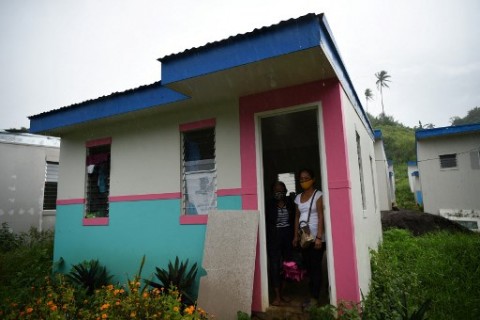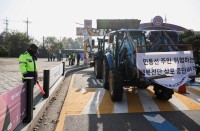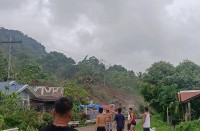
by Allison JACKSON
GUINOBATAN, Philippines (AFP) — A year after a powerful storm sent an avalanche of volcanic rock and sand crashing down, burying her house, Philippine food vendor Florivic Baldoza still lives in an evacuation centre.
As global warming brings increasingly extreme weather, she now fears “nowhere is safe”.
Hundreds of families from poor villages around Mayon volcano in Albay province on the country’s most populous island of Luzon are waiting for new homes after Typhoon Goni pounded the region last November.
“That’s the strongest I’ve ever experienced,” Baldoza, 40, told AFP, standing on a mound of dark sand that now covers the house she once shared with her husband and two teenage daughters.
Several hundred thousand people fled as Goni barrelled towards the archipelago nation — ranked as one of the world’s most vulnerable to the impacts of climate change.
But some residents in San Francisco village — including Baldoza’s family — ignored warnings to shelter in a school, confident a river dike built several years ago would protect them from flooding.
As the most powerful typhoon to hit the country last year dumped heavy rain on an area still sodden from another cyclone a week earlier, Baldoza realised her family was in peril when water began cascading over the several metres high cement wall.
They bolted to her mother’s house across the road as a devastating mix of water, volcanic sand and boulders smashed the dike further upstream and tore through the village.
“We were trapped inside the house,” Baldoza told AFP. “We were crying, my husband was separated from us — we thought he was dead.”
Lucky to be alive, but trapped in deep mud, Baldoza and eight relatives, including children, twisted their bodies from side to side to escape, then climbed out a window and up on to the roof.
Her husband, Alexander, survived by scrambling up a mango tree.
Holding on to a powerline to avoid being blown away by fierce winds, the family clambered over the top of several houses before reaching a taller building.
“Our house was being hit by boulders, but we couldn’t do anything,” said Baldoza, who watched helplessly as the torrent swept away the family’s motorised tricycle and motorbike.
“If we hadn’t left our house, we would have died.”
‘Disaster capital’
It is not the first time excessive rain has forced Baldoza to relocate.
About 23 years ago, before Baldoza got married, her mother sold their house in a flood-prone area of the same village and moved the family to higher ground.
“We didn’t expect that we would experience the same thing,” Baldoza said.
“I don’t think there’s a safe place anymore. Wherever we go, we get flooded.”
Baldoza visits the site of her house most days as she sells home-cooked meals and soft drinks to workers repairing the damaged dike.
“I feel like crying because I raised my children here, this is where they were baptised, my husband and I were married here,” she said.
Baldoza’s family now lives in a classroom in the nearby Marcial O. Ranola Memorial School, which has been converted into an emergency evacuation centre.
Face-to-face classes have been banned in the Philippines since the start of the coronavirus pandemic.
Families in Albay province, dubbed the nation’s “disaster capital”, are used to spending a few days every rainy reason in shelters.
About a quarter of the roughly 20 storms and typhoons to hit the Philippines every year affect the impoverished region, wiping out crops, homes and infrastructure.
A year after the mudflow upended their lives, a hundred families are still at the school, sleeping in classrooms and cooking in makeshift kitchens.
Despite the hardships, Baldoza tries to keep life as normal as possible for her family. Their pet dogs and cats roam around the classroom which is divided by curtains into sleeping and living areas.
Her youngest daughter recently turned 18 and they all dressed up for a traditional coming-of-age party.
But Baldoza worries about the future of her children.
“The storms are getting stronger,” she said. “How will they survive if we’re gone?”
‘You can’t stop typhoons’ –
Many houses in San Francisco are still partially buried in the volcanic sand and rocks that swamped the village, elevating the ground level and reducing the height of coconut trees.
Residents have dug trenches around the perimeter of their homes so they can get inside. Some are still shovelling out debris.
Albay climate change activist Bill Bontigao said Goni was a “wake-up call” and urgent action was needed to prepare the region for stronger cyclones.
“I’m worried that the next generations, my nephews and nieces, won’t have a good future,” Bontigao, 21, told AFP.
Around 170,000 people were exposed to mudflows from the slopes of Mayon, the country’s most active volcano, said Eugene Escobar, head of the research division of the Albay Public Safety and Emergency Management Office.
More mudflows were likely as climate change warmed the planet and increased the “frequency and intensity of typhoons and rain”, Escobar told AFP.
The “cheapest solution” was to relocate vulnerable residents to safer areas and provide them with social and economic support, he said.
“You can’t stop typhoons… we have to accept the fact that we are in a disaster-prone area.”
But Baldoza fears “nowhere is safe” in Guinobatan municipality — including the new village where her family has been given a 25-square-metre house.
It is about a half hour drive from San Francisco where her husband still works as an electrician, but they have no money to rent or buy somewhere closer.
“Once we move in I’ll have it blessed so we’ll be lucky here,” Baldoza said, standing at the front door of the tiny house, cheerfully painted white, aqua, pink and blue.
“We hope it’s safer.”
© Agence France-Presse








